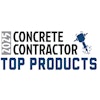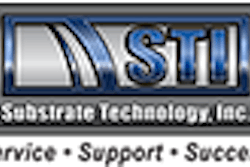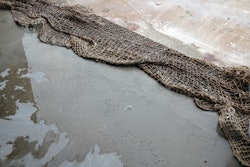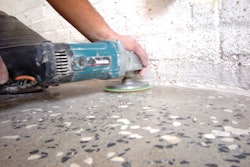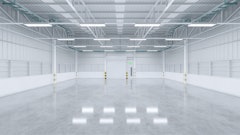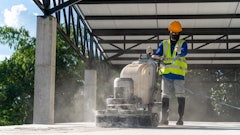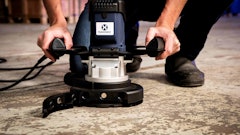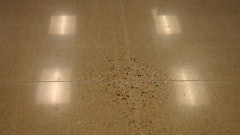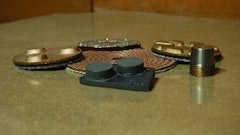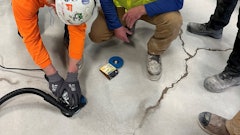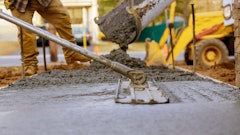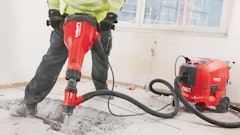
There is money to be made as a contractor by supplying the maintenance of polished concrete after the initial project is complete. While the concept of maintaining a polished floor may not seem as attractive as doing the work itself, a steady concession from maintenance products is good for a contractor’s revenue flow. This will maintain the relationship with the end-user and keep your final work looking great for years to come.
Much like a car needs regular maintenance to function on a daily basis, so do polished concrete floors. If the most expensive vehicles were left to run without oil, coolant or transmission fluid, it wouldn’t be long before the operation of the car was impaired or stopped altogether. Polished concrete is no different!
The allure of polished concrete has always been its ability to save a building owner money. A polished concrete floor maintenance costs’ are far lower than traditional floor coverings and never needs to be ripped out and replaced as compared to traditional floor coverings. The polished concrete does require some maintenance. That is an opportunity for a polishing contractor to continue making money from his or her past clients.
Polished concrete floors, like any other floor covering, will become dirty as a function of its intended use. Polished concrete’s daily intended use is accommodating traffic; foot or wheeled. As the surface becomes dirty with different contaminants like dirt and sand particles, the traffic will then become the "machine" that moves these contaminants across the polished surface. This movement causes mechanical abrasion by the particles being trapped between the traffic (foot traffic or wheeled traffic) and the polished surface. Consider the presence of sand particles being repeatedly dragged across a polish surface and you understand why a polished concrete floor will lose its shine. Another example would be a shopping cart loaded with 50 pounds of groceries, having hard rubber wheels and being rolled across a floor covered by particles of sand or grit. The origin of the sand or grit will vary but the most likely place it was transported from would be the parking lot outside the store or the cart-corral. Having this action take place daily (in some cases 24/7) it will not be long until the densest, most polished concrete begins to exhibit signs of wear and loss of shine.
Given that polished concrete floors are expected to handle traffic but inherently unable to defend against common contamination, prevention and remediation are the only way to ensure the polished concrete retains its hardened polish surface.
Prevention
The introduction of contamination from consistently dirty areas such as parking lots (asphalt, concrete, gravel or dirt) can be greatly reduced by the use of devices that clean both foot and wheeled traffic and the majority of debris picked up by them. A walk-off mat is an inexpensive and passive way of actively cleaning shoes and wheels of contamination brought from a parking lot. The strategic placement at every single entry point ensures that most dirt and debris will be caught by these walk-off mats. As traffic from outside passes over the mat, the materials used to make the mat attract and retain the dirt and sand instead of letting the contamination pass to the area of polished concrete. The key to successfully employing the use of walk-off mats is the regular cleaning and replacement of them based upon the quantity of traffic over a given period of time. As the mats collect debris, they will eventually become full of this contamination that must be removed by vacuuming or mat replacement. If walk-off mats are not maintained, then they themselves can become the source of sand and grit introduction. Any reputable janitorial service can give recommendations about walk-off mat types and the replacement schedule based upon the facilities traffic load.
Remediation
While walk-off mats are good for stopping the majority of debris from coming in contact with the polished surface, there will always be a percentage that makes its way to the polished concrete. Daily maintenance is best performed through the use of an auto-scrubber. The common auto-scrubber should be sized appropriately for the area it is intended to clean to save on labor to perform the cleaning. The auto-scrubber should be a rotary style machine and not a cylindrical design. Rotary style are the most common and depending on size will have one or two mono-rotational heads or discs that carry a buffing or scrubbing pad. Regardless of the manufacturer, the appropriate cleaning pads for cleaning a polished concrete floor should be white in color or carry a name like Buff or Polish. Buff or Polish denotes the pad is non-abrasive and only used to remove light contamination with water.
As for chemicals that may be needed to perform this daily cleaning, there are none, water is all that is needed to remove the surface contamination. In the cases of oil or other spills, a neutral detergent can be used to emulsify the spill but only in these areas should a detergent be used. The soap that is chosen for these ‘spot’ treatments cannot be acidic in any way, as any acid introduced to polished concrete will etch/damage the polish.
Quarterly or semi-annually the polished concrete floor should be treated with a diamond pad and chemical formulated for polished concrete floor care. Manufacturers of these products abound and the contractor has many choices for what to buy. A general description of the maintenance systems offered specifically for polished concrete will consist of a diamond powder impregnated pad and a hardening/cleaning chemical. The diamond pads look like any common buffing pad that is used on an auto-scrubber. The difference is, the pad will have a resin and diamond powder mixture on the surface of the pad. The diamond powder that is present will be effective in buffing the polished concrete to keep it looking good and mechanically sound to combat the traffic. The chemical will usually be in liquid concentrated form which is then added to the auto-scrubber solution tank. Work execution is done by using the solution of water and concentrate fed through the auto-scrubber to the diamond pads. The process will look like a standard floor cleaning. The combination of the chemical and diamond pads scrubbing the floor will yield a rejuvenated polished surface that looks great and is also denser. Some may think this could be an expensive proposition, but most systems on the market today cost around $.05 per square foot to use (cost of diamond pad and chemical). If done on a semi-annual basis, the building owner will have a floor maintenance cost of $.10 per square foot to keep their polished concrete floors looking great for years to come.
Where does the contractor come into the equation and how does he or she make money from this opportunity? You, as the contractor, are the best person to offer the products that are best suited for the after-care of the polished concrete. The special needs of polished concrete to maintain its brilliance and strength are not common knowledge for the janitorial industry. There is no one better than the expert that performed the polishing to advise the customer about the best way to maintain their polished concrete floor. A contractor can easily expand his or her profit channels by offering this value added service to their existing and past client portfolio.


